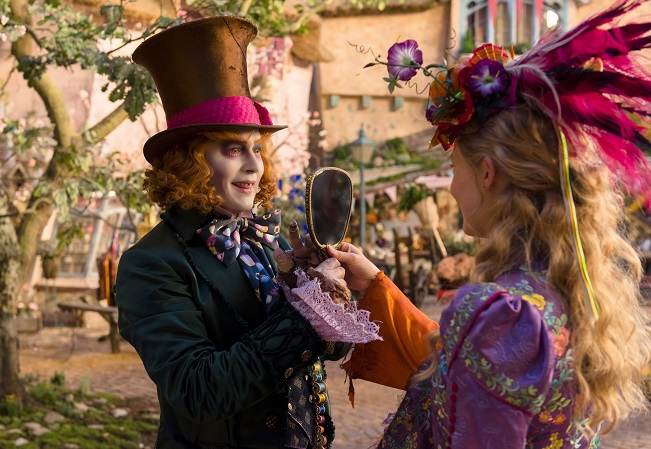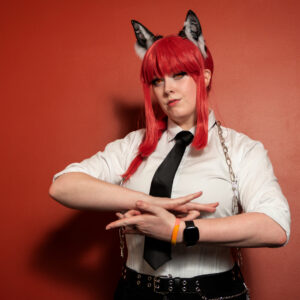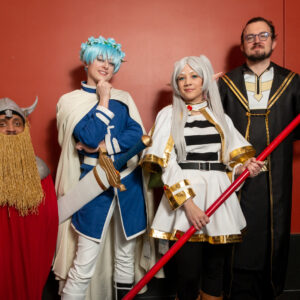Alice Returns In Lightweight Hypercolor Sequel

A new Tim Burton movie is a lot like Forrest Gump’s box of chocolates; you never know what you’re going to get. Will it be a rich, dark bonbon full of alienation, suburban ennui, and a delightful pumpkin king having an existential crisis? Or will it be shiny, sugary confection, pretty and enjoyable but less than unsatisfying, full of overdeveloped story and hammy Johnny Depp?
Burton’s latest creation, Alice Through the Looking Glass, is more cotton candy than Lindt truffle. It’s incredibly colorful, beautiful to look at, and kids love it, but it’s spun from almost nothing and leaves you hungry.

Alice Through the Looking Glass picks up some time after the end of 2010’s surprise blockbuster, Alice In Wonderland. Alice Kingsleigh (Mia Wasikowska) is now the confident, capable captain of her father’s ship, the aptly-named Wonder. Returning home after a long voyage, she finds Victorian London less than hospitable to ambitious, competent women. In an effort to secure her next trip, she crashes a gala thrown by Hamish (Leo Bill), the foppish suitor she previously rejected. The eye-popping iridescent Chinese cheongsam dress she wears sets the visual tone for the rest of the movie. When she spots blue butterfly Absolem (voiced by the wonderful Alan Rickman in his last role before his death), she follows him through an enormous mirror and back to Underland. She literally drops in on everyone from Alice In Wonderland: the White Queen (an eternally ethereal Anne Hathaway), the Tweedles (Matt Lucas) and the rest of the tea partiers. Tarrant Hightopp, aka the Mad Hatter (Johnny Depp at his twitchiest and most affected), is languishing in his hat-shaped house, pining for his lost family. To help restore Hatter to his usual mad-cap madness, Alice is given a quest: find a powerful McGuffin, travel through time, and find out what happened to the Hightopp family. Along the way, Alice, the Red Queen (a delightfully batty Helena Bonham-Carter) and the rest all learn valuable lessons about family, honesty, and self-reliance.
Don’t be surprised if you can’t recall a time-travelling heroine or a missing Hatter clan in Through the Looking Glass and what Alice Found There. As it says in the credits, the movie is “based on characters created by Lewis Carroll.” In fairness, the book as written would be difficult to film: it’s a witty collection of stories featuring Alice and the Red Queen playing human chess on a life-sized scale, full of inventive wordplay, and sharp satire. Sadly for Disney filmmakers, the book contains little in the way of epic battles, female empowerment, or CGI dragons. And, considering his outsize role in both the movies and popular mythology, very little actual Mad Hatter.
Screenwriter Linda Woolverton (Maleficent) gives a nod to the book, cherry-picking visuals like Humpty Dumpty and all the King’s horses and men on a giant chess board. She also has Alice constantly saying her well-known expression, ‘curiouser and curiouser.’ The rest of the story is invented out of thin air, and seems to rely heavily on other Burton movies.
Hatter is given a generic backstory to explain his eccentricities and his current funk: an aloof father who doesn’t understand his playful son and disapproves of his less-formal approach to the family profession. If that sounds familiar, it’s because it’s virtually the same the invented backstory that drove Willy Wonka in Burton’s Charlie and the Chocolate Factory. It doesn’t help that Johnny Depp plays both Willy Wonka and the Mad Hatter; their quirks are much the same, and the overgrown man-child schtick is old hat (pardon the pun) at this point.
In contrast, Alice is the Disney princess we’ve been waiting for. She’s more Rey than Sleeping Beauty. She isn’t waiting for anyone to rescue her; she’s doing the rescuing. She faces difficult truths and grows up gracefully. And while future movies are unlikely to boast “featuring Oscar-winner Mia Wosikowska,” she sells Alice’s plucky self-reliance and can-do attitude.
After the bleak, dark palette of Batman V Superman or the blue-tinted X-Men: Apocalypse, it was refreshing to watch a movie full of bright, unabashed color. The art direction and visuals are stunning. The costume design is outstanding, the stuff of cosplayers’ dreams. Alice’s Victorian maritime uniforms are gorgeous, and Joseph would be jealous of her technicolor purple and fuschia jacket. Sacha Baron-Cohen joins the cast as Time, a wonderfully over-the-top role perfectly suited to his scenery chewing. His massive, baroque, steampunk-flavored costume is as absurd as his accent, equal parts Mr. Chekov and Arnold Schwarzenegger.
As Anton Ego said in Ratatouille: We critics thrive on negative criticism, which is fun to write and to read. Sure, the story is a rehash, the acting is hammy, the ending is telegraphed, and the lessons are learned at little cost. Nonetheless, Alice Through the Looking Glass is fun, campy, gorgeous, and very Burton-esque. Perhaps most importantly, the 10-year-old critics were shrieking this review as they left the screening: “I LOVE ALICE THROUGH THE LOOKING GLASS.”
Alice Through the Looking Glass — Grade: C+



